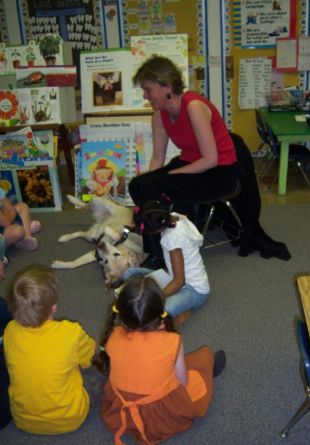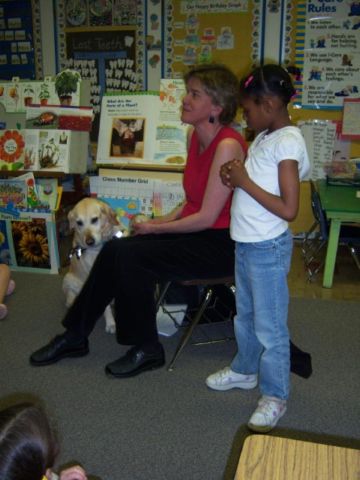Are Little Kids Old Enough to Use Service Dogs?
May 27, 2008 • 19 Comments • Posted in book tour, guide dogs, Seeing Eye dogs, Uncategorized, Writing for Children During our visit to Washington Irving Elementary School in Oak Park last week, we talked about Hanni being a “working dog.” A student piped up and asked, “What other jobs do dogs do?” The girl next to him said she knew that some dogs look for people who are lost. “Yes,” an adult on hand said. “Search and rescue dogs!” One student had read a book about sled dogs, another knew about police dogs, firehouse dogs.
During our visit to Washington Irving Elementary School in Oak Park last week, we talked about Hanni being a “working dog.” A student piped up and asked, “What other jobs do dogs do?” The girl next to him said she knew that some dogs look for people who are lost. “Yes,” an adult on hand said. “Search and rescue dogs!” One student had read a book about sled dogs, another knew about police dogs, firehouse dogs.
Once the students had run out of ideas, I told them what I knew about hearing dogs and service dogs. “My friend Melanie is hard of hearing,” I said. “Her dog Pixie would jump into Melanie’s lap if the doorbell rang.” Their eyes got big. Don’t ask me how I knew this, I could just tell. “Oh!” I said with a laugh. “I forgot to tell you one thing.” Pixie was much smaller than Hanni, I reassured them. A collective sigh of relief swelled from the crowd.
Dogs help fetch things for people in wheelchairs, I told them. Dogs open doors for people who can’t use their hands very well. Some dogs even take the laundry out of a dryer for people who can’t reach in to do it themselves.
What I didn’t discuss with them, however, was some of the controversy surrounding service dogs. That very morning I had read a news story about an autism assistance dog who had been paired up with a four-year-old named Jayden Qualls. When Jayden showed up at his California preschool with his new autism assistance dog, they were denied access.
School officials said they need to determine if Houdini is a service dog or a companion dog. They also need more time to find out if the dog is warranted at the school and if so, how he fits into the flow. The Americans with Disabilities Act gives Jayden the right to have Houdini in school, Qualls said. Jayden’s parents bought Houdini for $13,000 from a nonprofit called Autism Services Dogs of America.
That $13,000 price tag startled me. Guide dogs can cost up to $50,000 to train, but the guide dog user is never charged that much. My first dog, Dora, cost me $150. Subsequent Seeing Eye dogs cost $50.
And though Jayden’s mom believes the Americans with Disabilities Act (ADA) gives Jayden the right to have Houdini in school, the jury is still out on that one. To qualify as a service animal under the ADA, a dog must be “partnered with a person with a disability and individually trained to do work or perform tasks for the benefit of that person.” Courts would have to decide whether Houdini performs tasks for Jayden or simply acts as Jayden’s companion.
tasks for Jayden or simply acts as Jayden’s companion.
However this all resolves, there is one last question just begging to be asked. Can a four-year-old take care of a dog? If not, Who cares for the dog while the dog is at school with the child? You have to be at least 16 years old to train with a Seeing Eye dog— the Seeing Eye believes working with a guide dog demands a certain amount of physical, mental, and emotional maturity. In simple terms, in order to work with a Seeing Eye dog, you have to be mature enough to take care of a dog.
All pretty complicated stuff, and a lot of grey area here. I guess I was feeling too lazy – and we were having too much fun – to bring this all up to the students at Washington Irving. I can tell you what the 5+ year olds in that classroom would have said about all this anyway. I mean, c’mon. Everyone knows four-year-olds are babies.

